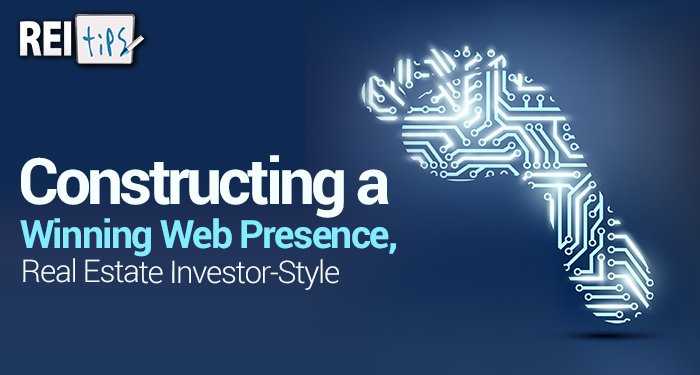With some thought, you might wonder if developing a website for your REI business is even worth the time and money.
The answer, in 99.9% of cases, is a resounding… YES.
If your goal is to grow your business and maintain a profitable venture, a website is one branding/marketing technique that cannot be compromised.
So, does your website need to look like it was designed by a top-notch developer and written by an expert marketing professional?
No. (Although, those are huge bonuses.)
The main goal of having a website is simply that… to have a web presence.
By having another platform where interested buyers or sellers can learn more about you, you’ll be marketing yourself to people that you would have never reached otherwise.
When it comes to building your web presence, you don’t need to spend a ton of time or invest a ton of financial resources. But, you can if you want to. That’s the great thing about creating a website – it can be as simple or complex – or as cheap or expensive – as you want it to be.
So, I want to cover the various aspects of building your web presence – as well as the different ways you may go about doing this. Let’s get started!
From Square One
Really, when it comes to building a website, you can make this as simple or as complex as you want…
If you have a small budget and just want something that serves a very basic yet functional purpose, you can do that. If you want something that’s very impressive and will take some time and money to develop, you can do that. If you want anything in between – guess what? – you can do that.
It’s important to consider:
1. Your overall business goals
2. Your budget
3. How much time you want to spend on the development of your website
4. The main purpose of your website/what you hope to gain from it
5. Your long-term plan for maintaining and updating your website
Take some time to think through each of these items and write down your plans. Once you have a clear picture of what you’re hoping to achieve, you’ll be ready to select a domain name.
Choosing Your Domain Name
This initial step is one that you should take some serious time to think about. Choosing your domain name (such as www.JPMoses.com) is a huge decision. Here are a few things to keep in mind:
 Keep it simple. You want to choose a domain name that’s super easy for people to remember. You should be able to tell someone, audibly, what your website name is – and not have to repeat it 18 times.
Keep it simple. You want to choose a domain name that’s super easy for people to remember. You should be able to tell someone, audibly, what your website name is – and not have to repeat it 18 times. Keep it relevant. If your main business is wholesaling, you might want to include that in your domain name. This way, people who are searching online for wholesalers will find your website more quickly.
Keep it relevant. If your main business is wholesaling, you might want to include that in your domain name. This way, people who are searching online for wholesalers will find your website more quickly. Keep it local. You may also want to include your region or city name in your domain name. Again, this is an effective way for people in your area to find your services online.
Keep it local. You may also want to include your region or city name in your domain name. Again, this is an effective way for people in your area to find your services online.
Some examples of awesome domain names are:
 www.DenverWholesale.com
www.DenverWholesale.com www.JohnSmithRealEstateInvesting.com
www.JohnSmithRealEstateInvesting.com www.WeBuyHouses-Cleveland.com
www.WeBuyHouses-Cleveland.com
Putting Everything into Action
Now comes the fun part… creating the website and getting it up and running.
There are so many different ways you can go about this. (And I could probably write an entire book about all the options.) But, for today, I want to present 3 routes you could choose to create your website.
Let’s take a look at each one…
Option #1: Using a Template
If you’re operating with a shoestring budget, and you’re hoping to complete your website as quickly as possible, you might want to consider purchasing a website template. In a nutshell, this is when you purchase the basic layout/design of a website, and then you can make minor adjustments or customizations.
Sites like WordPress, Wix and Squarespace are just a few options of good places to start. Of course, you’re going to want to research your options thoroughly. Just type “real estate investor website templates” into your internet search engine to get started.
 Benefits: This is the cheapest method for creating a website, it’s quick and it requires minimal effort – on your part.
Benefits: This is the cheapest method for creating a website, it’s quick and it requires minimal effort – on your part. Disadvantages: Your website will have a basic, cookie-cutter layout, and you’ll have very limited options for customization or advanced features. You’ll also be responsible for maintaining the website on your own.
Disadvantages: Your website will have a basic, cookie-cutter layout, and you’ll have very limited options for customization or advanced features. You’ll also be responsible for maintaining the website on your own. Good for: Investors who are just getting their start in the biz, and who want to have a web presence that’s affordable and easy to establish.
Good for: Investors who are just getting their start in the biz, and who want to have a web presence that’s affordable and easy to establish.
Option #2: Using a REI website with lead generation services
Using a lead generation website/service that is created specifically for real estate investors is another great option for building your web presence.
These services – such as OnCarrot or LeadPropeller – have predesigned website templates (similar to Option #1), but they also offer the added services of built-in Search Engine Optimization (SEO), lead generation services and tracking, information security and much more. Many of these systems offer different levels of services, depending on how much you’re willing to pay.
 Benefits: These systems allow you to create more of a customized appearance for your site, without shelling out thousands of dollars. Plus, you can benefit from their services, which are designed to help you score more deals.
Benefits: These systems allow you to create more of a customized appearance for your site, without shelling out thousands of dollars. Plus, you can benefit from their services, which are designed to help you score more deals. Disadvantages: The pricing may be too high for beginner investors, and you still won’t have 100% control over the way your site looks and operates.
Disadvantages: The pricing may be too high for beginner investors, and you still won’t have 100% control over the way your site looks and operates. Good for: Investors who have several years of experience (and success) under their belt, and who are ready to take their business to the next level with some more advanced marketing techniques.
Good for: Investors who have several years of experience (and success) under their belt, and who are ready to take their business to the next level with some more advanced marketing techniques.
Option #3: Using a Professional Developer to Create a Custom Site
You’re going to need to get your wallet out for this one…
Professionally designed websites will cost you a pretty penny. But, as the saying goes… you get what you pay for. This option will give you complete control over the look and functionality of your website. Plus, your website will look entirely unique… which is a great way to attract attention.
 Benefits: Your website will be top-notch, and have the best features for attracting and converting leads. If you also hire a developer for long-term maintenance of the site, your content will always be fresh and up-to-date, which will help you rank higher in Google searches.
Benefits: Your website will be top-notch, and have the best features for attracting and converting leads. If you also hire a developer for long-term maintenance of the site, your content will always be fresh and up-to-date, which will help you rank higher in Google searches. Disadvantages: The upfront cost and maintenance costs can be pricey. For the initial web design, you can expect to pay upwards of $5K.
Disadvantages: The upfront cost and maintenance costs can be pricey. For the initial web design, you can expect to pay upwards of $5K. Good for: The “big” guys – investors who have built very profitable businesses, and who often have a team of people working under them.
Good for: The “big” guys – investors who have built very profitable businesses, and who often have a team of people working under them.
Creating Impactful Content
Regardless of which option you choose, every REI website has a similar goal: to tell people about your business, and to spark their interest in working with you (whether it’s buying your property, selling you a property, doing wholesale deals, etc.).
Make sure your website isn’t cluttered with outdated content or bogged down by long paragraphs of text that no one wants to read.
The main goal of your website is to get people to contact you. So, make sure you have:
 Your contact information prominently displayed
Your contact information prominently displayed A short bio about yourself and the type of business you do (along with the markets/cities where you invest)
A short bio about yourself and the type of business you do (along with the markets/cities where you invest) Regularly updated content (for example, a blurb on a property you recently fixed and flipped or a video tour of a property you’re currently selling)
Regularly updated content (for example, a blurb on a property you recently fixed and flipped or a video tour of a property you’re currently selling) A squeeze page (or landing page) that allows people to input their contact info, if they’re interested in speaking with you
A squeeze page (or landing page) that allows people to input their contact info, if they’re interested in speaking with you Links to your social media
Links to your social media
Building a Social Media Presence
While creating an effective and eye-catching website is important, you also need to make sure you’re active on social media – this will really bring your whole web presence together.
At minimum, you should have a Facebook profile and a YouTube account. Just a quick word about both:
 Facebook is a great place to join real estate investing “groups.” Simply search “real estate investors” and your city/region, and you should find several options. By joining these groups, you’ll make invaluable connections with other investors in your market – who you can bounce ideas off of, and who you might even do deals with.
Facebook is a great place to join real estate investing “groups.” Simply search “real estate investors” and your city/region, and you should find several options. By joining these groups, you’ll make invaluable connections with other investors in your market – who you can bounce ideas off of, and who you might even do deals with. YouTube is the perfect platform for posting video tours of your properties for sale. You don’t have to be a professional videographer (thank goodness). Just a simple walkthrough of the property, along with a simple explanation of each room, is sufficient.
YouTube is the perfect platform for posting video tours of your properties for sale. You don’t have to be a professional videographer (thank goodness). Just a simple walkthrough of the property, along with a simple explanation of each room, is sufficient.
Create a goal for yourself (such as posting on Facebook 3 times per week or uploading a video to YouTube twice per month) and stick with it. The exposure you’ll gain from your social media accounts will probably surprise you… and it should lead to some awesome property deals.
The Moral of the Story
Just like any marketing technique, the development of your web presence can be done 100 different ways – in terms of how much you want to spend, what you’re trying to accomplish and how much time you want to invest.
I hope this post has given you a good starting point for developing your own web presence. It really doesn’t have to be an intimidating prospect, and it’s an extremely valuable way to build your brand, establish credibility in your market, and – ultimately – support a successful investing business.
Now, It’s Your Turn
Have you looked into options for starting your own website? What challenges are you facing so far? Found any secret tips you can share?




